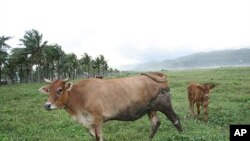Scientists have developed technology that can be carried to the field in a laptop suitcase to diagnose diseases in animals on the spot. The joint division of the International Atomic Energy Agency (IAEA) and the Food and Agriculture Organization (FAO) are using molecular diagnostic methods, once only available in laboratories. Dr. Hermann Unger, Technical Officer of the IAEA’s Animal Production and Health Section, explained to VOA how the devices were developed.
“Three groups in parallel developed tests as a key parameter for avian influenza and came up with three different solutions. We now have three basically competing systems for molecular diagnostics in the field, which means you just pack a small suitcase, a small box in your car. You drive to the location where a case is suspected. You take a sample. In two of the cases you just take blood or a nasal swap, insert that into a cartridge, and insert the cartridge into a reader. An hour later, you have results, because the instrument will tell you if the sample was positive for avian influenza or river fever or [some other illness],“ explained Unger.
Dr. Unger said the third diagnostic method came from the IAEA labs and requires one manual extraction of the sample. “That means you have to boil the sample before you can apply that, “said Unger.
Helpful devices
The devices are very helpful in rural areas, but will require cooperation with country’s government to get immediate results.
“The problem which you always have to see is, if I identify a disease somewhere in a very remote place, I must be able to transmit this information, for instance, to the ministry of health, to a healthcare situation, to a veterinary laboratory so that action can be taken. In all three set-ups of the machines, there is a GSM, mobile phone capacity, so that you can transmit the results to a central lab, so that support can come from outside,“ said Unger.
He says two commercial systems are already available to the public. Field testing on the devices is being done in some African countries including Sudan and Kenya.








